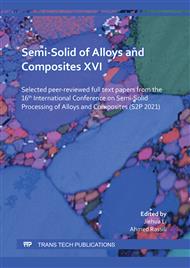p.65
p.71
p.82
p.98
p.105
p.111
p.119
p.127
p.133
Phase Transformation of M2 High Speed Steel during Semi-Solid Cooling and Conventional Cooling
Abstract:
In this paper, the fundamental microstructure evolution of M2 high speed steel was investigated during semi-solid controlled cooling and conventional cooling, respectively. Semi-solid controlled cooling was conducted at 1260 °C with cooling rates from 0.1 to 10 °C/s, while conventional cooling was conducted at 1200 °C and 890 °C with different cooling rates. The continuous cooling transformation curves were plot according to the microstructure evolution. The results showed that microstructure transformation behavior of cooling structure in semi-solid temperature range was different from that of conventional process. For semi-solid specimen, the solid austenite dissolved more alloy elements, and the austenite stability was increased. The solid matrix was pearlite structure in the samples with cooling rate of 0.1 °C /s. When the cooling rate reached 1 °C/s, the granular pearlite disappeared and martensite lath was formed. The structure was relatively uniform, on which there were large carbide with regular shape. The solidified liquid phase showed a network shape surrounding the solid particles. The size of solid particles showed a decreasing trend with the increase of cooling rates. For conventional cooling process, the large eutectic M6C carbide and the small precipitated MC carbide could not be dissolved by austenitized at 890 °C. Increasing the austenitization temperature helped dissolving part of the carbides. The hardenability of M2 steel was high. The hardness has increased to a high level for both semi-solid and conventional specimens when cooling rate reached 1 °C/s. No obvious increase happened when cooling rate continued increasing.
Info:
Periodical:
Pages:
105-110
Citation:
Online since:
January 2022
Authors:
Price:
Сopyright:
© 2022 Trans Tech Publications Ltd. All Rights Reserved
Share:
Citation:


